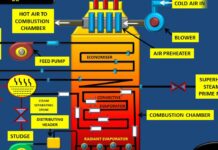MACHINE DESIGN :IMPORTANT CONCEPTS SUMMARY 2
MACHINE DESIGN IMPORTANT Concepts and definitions summarised in this blog.
FLUCTUATING LOADING AND MACHINE DESIGN :
Q8. WHAT IS A NOTCH AND ITS EFFECT ON MACHINE DESIGN.
ANS. NOTCH : Defined as a purposely introduced defect (usually U-shaped or V-shaped or circular shaped) on a planar machine component.
Therefore, it causes stress concentration on its own region.
Factor governing this effect came to be known as Notch Sensitivity Factor (q).
q = (Inc. of Actual stress over Nominal stress)/(Inc. of Theoretical stress over Nominal stress)
Q9. WHAT ARE THE ‘THEORIES OF FAILURE’ IN FATIGUE/FLUCTUATING LOADING.
ANS. The THEORIES OF FAILURE in fatigue/fluctuating loading are:
1)SODERBERG LINE
2)GOODMAN LINE
3)GERBER LINE/CURVE
SPRINGS 1 :
Q10. WHAT DO YOU UNDERSTAND BY SPRING?
ANS. An elastic machine element, which deflects under external load action and returns to its original shape on load removal.
It can take any shape and form depending upon the application.
They have various forms of design made of round and rectangular wires, some of flat plates, coned discs or rubber blocks.
A Spring mainly designed in order to: Provide a pull, a push, or maybe a torque.
Q11. WHAT ARE THE FUNCTIONS AND APPLICATIONS OF SPRINGS?
ANS. The functions of a SPRING are:
1) Springs are used to absorb shocks and vibrations.
2) They mainly used for energy storage.
3) Used to measure force i.e used in measuring instruments.
4) Used to apply force and control machine motion and its mechanics.
Following are the applications of springs:
1) Vehicle suspension springs, railway buffer springs etc. (Shock and vibrations)
2) Clocks ,toys, starters etc. (work due to spring stored energy)
3) Weighing balance and scales (Force measurement)
4) Cam and follower ,Engine valve mechanism (provide relative motion between the two as well as control motion)
Q12. MENTION TYPES OF SPRINGS GENERALLY USED IN APPLICATION.
ANS.
The classification usually is made on the basis of shape of the spring. The most common types used are :
1)HELICAL SPRINGS
a) Helical Compression/Extension Springs
b) Helical Torsion Springs
2) MULTI LEAF SPRINGS
Q13. MENTION TWO SYSTEM OF EQUATIONS USED FOR HELICAL COMPRESSION SPRING DESIGN.
ANS. The two Equations used for helical compression spring design are :
1) LOAD-STRESS EQUATION
2) LOAD-DEFLECTION EQUATION
SPRINGS 2 :
Q14. WHAT DO YOU MEAN BY SURGE IN SPRINGS?
ANS. When a spring subjected to external periodic force , the spring starts vibrating or oscillating with a certain frequency. When the natural frequency of spring vibrations becomes equal to frequency of External periodic force; resonance occurs.
In this state, the spring experiences a wave of successive compression of coils . And this wave travels from one end of the coil to the other, then back to initial point and so on. This results in a continuous vibrational motion.
This vibratory motion ; now known as the condition of SURGE in a loaded spring.
Q15. SUGGEST SOME METHODS TO AVOID CONDITION OF SURGE IN SPRINGS.
ANS. The methods to avoid condition of surge in springs are as follows:
1) The frequency of spring designed in such a way that Frequency of Spring ≈15-16 times (frequency of periodic force) to avoid resonance.
2) Spring provided with friction dampers on central coils in order to avoid further propagation of surge wave and break its continuity.
3)Springs should be made of standard wires in order to avoid surge condition. On coils’ compression, the standard wired coils approaches each other closely. This produces coil friction ;thereby avoiding surge wave propagation.
Q16. WHAT ARE SPIRAL SPRINGS?
ANS. It is one of the most commonly used springs in various small scale and large scale industrial uses. It’s basically a spring consisting of a wire coiled usually in a flat spiral or in a helix. Also known as “Power spring” OR “Flat spiral spring”.
A Spiral spring consists of a thin strip of Rectangular cross section, wound in the form of Spiral as shown. Inner end of this wound strap fixed in the arbor which located at the center. Whereas, the outer end clamped to the drum , called ‘Retaining Drum’.
Q17. MENTION SOME APPLICATIONS OF SPIRAL SPRINGS IN DAILY LIFE.
ANS. Spiral springs are used in the following applications:
1) Watches and Cameras
2) Automatic Weapons
3) Toys (Mostly used)
4) Starters for small engines





